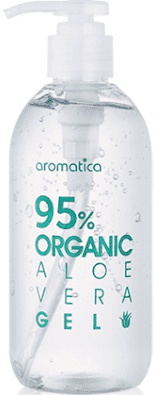
95% Organic Aloe Vera Gel
Highlights
Key Ingredients
Skim through
Aromatica 95% Organic Aloe Vera GelIngredients explained
The extract coming from the juice containing leaves of the Aloe vera plant. It's usually a hydroglycolic extract (though oil extract for the lipid parts also exists) that has similar moisturizing, emollient and anti-inflammatory properties as the juice itself. We have written some more about aloe here.
Propanediol is a natural alternative for the often used and often bad-mouthed propylene glycol. It's produced sustainably from corn sugar and it's Ecocert approved.
It's quite a multi-tasker: can be used to improve skin moisturization, as a solvent, to boost preservative efficacy or to influence the sensory properties of the end formula.

A pre-neutralised form of super common thickener, Carbomer. This means that it forms viscous gels immediately upon addition to water (while Carbomer has to be neutralized with a base), but it can also be harder to disperse evenly in the formula.
If you are into Japanese cuisine, you might know this guy as Japanese pepper or Sanshō pepper that is known for its unique fresh aroma and appetite increasing spicy sensation.
As for the skin benefits of Zanthoxylum Piperitum, it might have antioxidant effects (with active components called hyperoside and quercitrin), but more importantly, it is an antibacterial and natural preservative agent. It is pretty common in K-Beauty products, as it's one of the three natural extracts that make up the popular Korean preservative called EURO-NApre.
Combined with Usnea Barbata and Pulsatilla Koreana, these three extracts are claimed to form a natural preservative system that also has anti-inflammatory effects and might help with skin conditions such as blemishes, atopic dermatitis, and dandruff.
On the flip side, Zanthoxylum Piperitum contains fragrant components (Limonene and Citrone), that might irritate sensitive skin.
The extract coming from the alpine lichen, Usnea Barbata. It is known for its excellent efficacy against gram-positive bacteria, meaning that it can serve as a natural preservative and deodorant agent.
Its main biologically active component is usnic acid (a molecule produced only by lichens) that's not only an antibacterial agent, but also has antioxidant, anti-inflammatory and wound-healing promoting effects. According to manufacturer info, the antibacterial activity of Usnea Barbata makes the ingredient helpful against body odor, blemished skin, and dandruff.
It is also very common in K-Beauty products, as it is part of a popular Korean natural preservative system trade named EURO-Napre (combined with Zanthoxylum Piperitum and Pulsatilla Koreana).
The extract of Korean Pasque Flower that is mostly used for its antimicrobial and natural preservative activities. It usually comes to the formula combined with Zanthoxylum Piperitum and Usnea Barbata, as the three extracts make up a popular Korean natural preservative system trade named EURO-NApre.
The plant extract is also a traditional oriental herbal medicine that is known for its analgesic, anti-inflammatory, and astringent effects.
A colorless liquid used in small amounts as a so-called masking ingredient, meaning it can hide the natural not-so-nice smell of other cosmetic ingredients. It has a nice rose-like scent and can be found in several essential oils such as rose, neroli or geranium. It also has some antimicrobial activity and can boost the performance of traditional preservatives.
You may also want to take a look at...
| what‑it‑does | soothing | emollient | moisturizer/humectant |
| what‑it‑does | solvent | moisturizer/humectant |
| what‑it‑does | viscosity controlling |
| what‑it‑does | antioxidant | antimicrobial/antibacterial | preservative |
| what‑it‑does | preservative | antimicrobial/antibacterial |
| what‑it‑does | antimicrobial/antibacterial | preservative |





